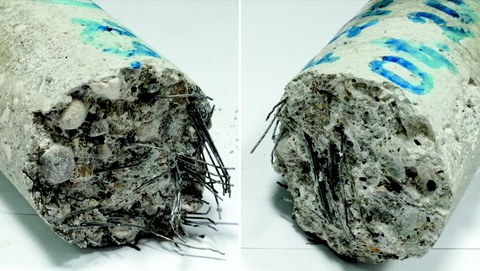Testing of fiber concretes in the split-Hopkinson bar
Table of contents
Project data
|
Titel | Title |
Report from year book 2020
Fibre fabulous dynamic properties

Fracture surfaces of a steel fiber-reinforced concrete specimen
Fibre-reinforced concrete is characterized by its high ductility compared to non-reinforced normal concrete. The fibres form a kind of discontinuous, three-dimensionally oriented, isotropic reinforcement in the concrete. The fibres bridge cracks at very small crack widths, transfer loads and develop crack resistance in the concrete. As a result, larger displacements are required to separate a concrete sample under direct tensile load compared to non-reinforced normal concrete, since tensile forces can still be transmitted despite cracks.
For the dimensioning of buildings against highly dynamic loads, such as explosions or vehicle impact, these properties can provide decisive advantages. On the one hand, the increasing ductility increases the deformability and thus also the energy absorption of the component. On the other hand, the resulting flying debris can be prevented, thus protecting people or goods inside the building.
To understand the load-bearing and damage behaviour of fibre-reinforced concrete under dynamic loading, knowledge of the decisive dynamic mechanical properties such as tensile strength, modulus of elasticity and fracture energy is required. These characteristic values were determined by dynamic spallation and splitting tensile tests in the split-Hopkinson bar in cooperation with the department of structural engineering of the Universität der Bundeswehr München. Concretes of the strength classes C20/25, C40/50 and C80/95 with steel fibre contents of 0 to 2.0% by volume and with alternative carbon and PP fibres were investigated.
It was found that with increasing fibre content, an increase in the modulus of elasticity and tensile strength under dynamic loading was obtained. Furthermore, the addition of steel fibres increases the fracture energy enormously, which increases further with increasing fibre content. This increase in the fracture energy leads to the fact that the resulting fragments have a significantly lower residual speed compared to the fragments of non-reinforced concretes. With a fibre volume content of 1.0%, a tenfold increase of the fracture energy compared to the non-reinforced specimens is possible. The alternatively examined carbon and PP fibres also lead to an increase in the fracture energy, but this is lower compared to the steel fibre reinforced samples. By increasing the deformability due to the fibres, the aim of preventing or reducing the flying debris in components subjected to impact loads can be achieved.
